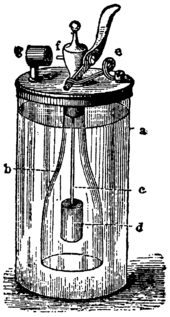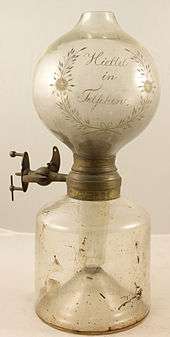Döbereiner's lamp
Döbereiner's lamp, also called a "tinderbox" ("Feuerzeug"), is a lighter invented in 1823 by the German chemist Johann Wolfgang Döbereiner; the lighter is based on the Fürstenberger lighter and was in production until ca. 1880. In the jar, similar to the Kipp's apparatus, zinc metal reacts with dilute sulfuric acid to produce hydrogen gas. When a valve is opened, a jet of hydrogen is released onto a platinum sponge. The sponge catalyzes a reaction with atmospheric oxygen, which heats the catalyst and ignites the hydrogen, producing a gentle flame.

- a. glass cylinder
- b. open bottle
- c. wire
- d. zinc
- e. stopcock
- f. nozzle
- g. platinum sponge

It was commercialized for lighting fires and pipes. The world's largest manufacturer of these lighters was Heinrich Gottfried Piegler from Schleiz in Thuringia (Germany)[1]. It is said that in the 1820s over a million of the "tinderboxes" were sold.[2]
Examples of the lighter are exhibited in the Deutsches Museum and in the old pharmacy at Heidelberg Castle.
See also
References
- Thomas, John M. (2017). The RSC Faraday prize lecture of 1989. Chem. Commun. Volume 53. p. 9189.CS1 maint: location (link)
- Principles and Practice of Heterogeneous Catalysis. p. 16. ISBN 9783527314584.
Further reading
| Wikimedia Commons has media related to Döbereiner's lamp. |
- Hoffmann, Roald (Jul–Aug 1998). "Döbereiner's Lighter". American Scientist. 86 (4): 326. doi:10.1511/1998.4.326.
- George B. Kauffman (1999). "Johann Wolfgang Döbereiner's Feuerzeug" (PDF). Platinum Metals Review. 43 (3): 122–128.